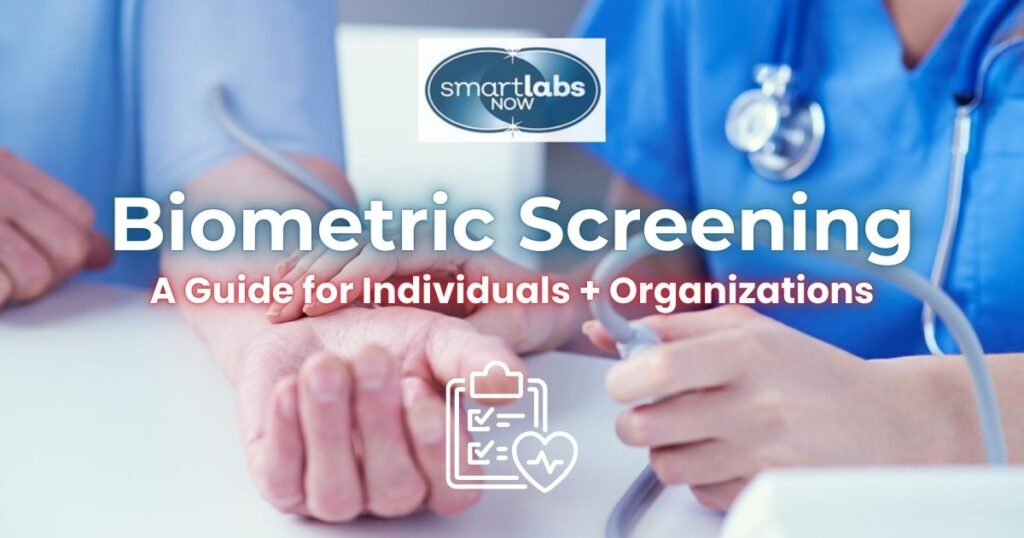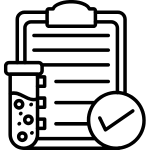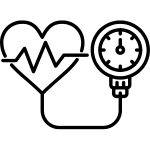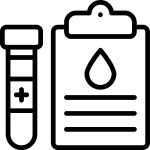
Biometric screenings are a key part of preventive health, empowering organizations to promote employee wellness, reduce health risks, and manage healthcare costs effectively.
This guide provides a detailed look at the purpose, components, benefits, and logistics of biometric screening solutions (especially in Portland 🙂).

A biometric screening is a clinical assessment that measures various physical and physiological indicators to evaluate an individual’s health status. This screening provides a foundational look at key health markers and helps detect early signs of health issues, fostering timely intervention and management.

Biometric screenings are an invaluable tool for both individuals and organizations. For employees, they offer a clearer view of their health status, while for employers, they help curb healthcare costs and support wellness initiatives.
Provides anonymized data on employee health trends, guiding organizations on health programs.
Early detection of conditions like hypertension and diabetes reduces the risk of severe health outcomes.
Identifying and addressing risk factors in employees promotes a healthier, more productive workforce.
Screening helps reduce long-term healthcare expenses by promoting preventive care.
Insights from biometric data can inform exercise and wellness programs tailored to the workforce.
Include various indicators to provide a comprehensive view of health status and track improvements.
Screening for risk factors, such as high blood sugar and blood pressure, helps prevent conditions linked to metabolic syndrome.
Provides individuals with specific insights, encouraging targeted health improvements.
Aggregate data allows employers to implement broad health programs targeting common risks.
Screening data enables organizations to assess employee health risks, leading to timely interventions.
Some screening options allow for self-collection, offering flexibility and convenience for employees.
Follow-up with health counseling provides personalized support for improving lifestyle habits.

A biometric screening examines several critical health indicators that collectively provide a holistic picture of an individual’s health.

Proper preparation can ensure accurate biometric screening results.
Understand the metrics being measured so you can prepare adequately.
Wear loose, comfortable attire for easy access to the arm and other areas needed for measurements.
This method is used for quick blood sampling; preparing mentally for it can reduce stress.
Staying well-hydrated improves blood sample quality and reduces the likelihood of dizziness.
Inform the provider about any medications, as some can affect screening results.
Convenient for workplaces, but preparation is still essential for accurate results.
Options for those preferring self-sampling.
A common method for collecting blood samples; staying calm and hydrated can help.

The biometric screening process involves several steps, which may vary depending on the organization or location.
Expect to have several values measured, such as BMI, blood pressure, and glucose levels.
Blood samples are typically collected through a fingerstick or venipuncture.
May be requested to understand risk factors and personalize results. Questions about drug/substance use are also typically included.
Many screenings take place in the workplace or other convenient settings.
Analyzing risk factors helps in creating personalized health advice.
Scheduling a designated time for the screening ensures a smooth process.
The choice of fingerstick, venipuncture, or self-collection varies.
A professional administers the screening, ensuring accurate data collection.

Results from biometric screenings are generally available within a few days to a few weeks, depending on the provider.

Participation in biometric screenings is generally voluntary, though organizations often encourage it through incentives and wellness program integration.
According to the Health Insurance Portability and Accountability Act (HIPAA), all personal health information gathered during these screenings is protected, ensuring privacy and confidentiality. Employers leverage this safeguard to assure employees that their biometric data will not be used improperly or without consent.
Organizations frequently collaborate with entities such as the American College of Occupational and Environmental Medicine (ACOEM), the Care Continuum Alliance, and the Health Enhancement Research Organization (HERO) to structure effective wellness programs that include biometric screenings. These programs often align with preventive health initiatives, focusing on identifying risk factors before they develop into costly health issues.
To motivate participation, many companies offer financial incentives such as cash bonuses, reduced health insurance premiums, or contributions to health savings accounts (HSAs).
These rewards help offset out-of-pocket healthcare costs and encourage proactive engagement in health improvement. Insurance companies may also integrate biometric screening results into their policies, offering lower premiums or additional coverage benefits for employees who complete screenings.
Biometric screenings often serve as a cornerstone of broader wellness programs aimed at enhancing employee health and reducing overall healthcare expenses. By identifying potential health risks early, these programs empower employees to make informed decisions about their well-being while helping employers manage rising healthcare costs.
Ultimately, while participation is voluntary, the combination of privacy protections, financial incentives, and alignment with preventive health objectives makes biometric screenings an attractive option for employees and employers alike.

Research and data strongly support the effectiveness and prevalence of biometric screenings in improving individual health outcomes and reducing overall healthcare costs for employers.
The Employee Benefit Research Institute (EBRI) highlights that biometric screenings when integrated into workplace wellness programs, help identify early signs of chronic diseases such as hypertension, high cholesterol, and diabetes. Early detection enables timely interventions, reducing the progression of these conditions and ultimately lowering health-related expenses.
The Kaiser Family Foundation reports that 53% of large firms and 30% of small firms now include biometric screenings as part of their employee wellness initiatives, underscoring their widespread adoption. These screenings are particularly effective in targeting preventable health issues. For example, high blood pressure and abnormal cholesterol levels—both leading risk factors for cardiovascular disease—are frequently identified during screenings, allowing for immediate action and treatment.
Community-driven programs, such as one in New Mexico, illustrate how biometric screenings can be used to address broader public health challenges. These programs emphasize screenings to identify not only physical health issues but also mental health concerns, such as depression, demonstrating the holistic value of such initiatives. By linking individuals with necessary healthcare resources, they play a vital role in reducing health disparities.
Biometric screenings also offer a financial advantage.
Chronic diseases account for a significant portion of healthcare spending in the U.S., and screenings help mitigate these costs. Employers investing in these programs often see a return in the form of reduced healthcare claims and improved employee productivity.
Whether in large organizations with extensive healthcare programs or small firms looking to support their workforce, biometric screenings have proven to be a cornerstone of effective wellness strategies.

Portland organizations have access to a variety of biometric screening options, including services offered by Smart Labs Now.
We specialize in providing quick, affordable, and discreet lab-testing solutions for businesses of all sizes and orientations 🙌.
If you’re interested in implementing comprehensive biometric screenings for your organization, please call us at ☎ (503) 477-7748.
Because nothing beats the solace of the huge cost savings you can reap by investing in your workers! 💖
Please consult your primary care physician before engaging with any pharmaceutical, natural substances, or activity regimens mentioned or prescribed in this post. Smart Labs Now is not responsible for health or life outcomes based on the information or recommendations provided. This account does not serve as a substitute for professional medical advice/help.